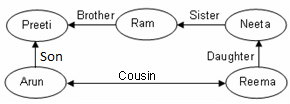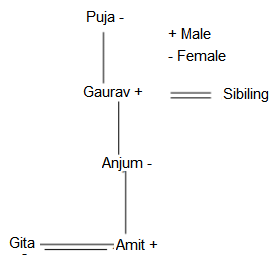SLAT Mock Test - 5 (New Pattern) - CLAT MCQ
30 Questions MCQ Test - SLAT Mock Test - 5 (New Pattern)
Directions: Complete the following series.
5824, 5242, ?, 4247, 3823
Directions: Find the missing term in the following series.
?, 97, 167, 257, 367, 497, 647
Preeti has a son named Arun. Ram is Preeti's brother. Neeta has a daughter named Reema. Neeta is Ram's sister. How is Arun related to Reema?
Directions: From the given five groups of letters, four of them are similar to each other in some manner, while one is different and this is to be choosen from the four alternative answers.
KP, MN, HR, GT, EV
Directions: Given question has a pair of CAPITALISED words followed by four pairs of words. Choose the pair of words which best expresses the relationship similar to that expressed in the capitalized pair.
BACHELOR : SPINSTER
Directions: In the following question, select the related word from the given alternatives.
Brick : Mason : : Colour : ?
Gita is Amit's sister. Anjum is Amit's mother. Gaurav is Anjum's father. Puja is Gaurav's mother. How is Gita related to Gaurav?
If the day on 4th April, 1988 was a Monday, then what was the day on 3rd November, 1987?
If the second Sunday in October 2002 fell on the 13th of the month, then the first Sunday in November 2003 would fall on which date?
If AROMA is coded as 24, GRAND as 22, then BREAD will be coded as
In a certain code, RAIN is written as 8$%6 and MORE is written as 7#8@. How is REMAIN written in that code?
Directions: The question consists of two statements, one labelled as Principle(s) and the other as Facts. You are to examine the Principle(s) and apply it/them to the given Facts carefully, and select the best option.
Principle: Whoever makes any gesture, or any preparation intending or knowing it to be likely that such gesture or preparation will cause any person present to apprehend that he who makes that gesture or preparation is about to use criminal force to that person, is said to commit an assault.
Facts: A shakes his fist at Z, intending or knowing it to be likely that he may thereby cause Z to believe that A is about to strike Z.
Decide whether any criminal liability arises or not.
Directions: The question consists of two statements, one labelled as Principle(s) and the other as Facts. You are to examine the Principle(s) and apply it/them to the given Facts carefully, and select the best option.
Principle: Whoever makes any gesture, or any preparation intending or knowing it to be likely that such gesture or preparation will cause any person present to apprehend that he who makes that gesture or preparation is about to use criminal force to that person, is said to commit an assault.
Facts: A shakes his fist at Z, intending or knowing it to be likely that he may thereby cause Z to believe that A is about to strike Z.
Decide whether any criminal liability arises or not.
Directions: The question consists of two statements, one labelled as Principle(s) and the other as Facts. You are to examine the Principle(s) and apply it/them to the given Facts carefully, and select the best option.
Principle: Where anything which is an offence is made up of parts, any of which parts is itself an offence, the offender shall not be punished with the punishment of more than one of such his offences, unless it is so expressly provided.
Facts: While A is beating Z, Y interferes, and A intentionally strikes Y. The blow given to Y is not the part of the act as A is voluntarily causing hurt to Z.
Would beating Y be counted as a voluntary offence or not?
Directions: The question consists of two statements, one labelled as Principle(s) and the other as Facts. You are to examine the Principle(s) and apply it/them to the given Facts carefully, and select the best option.
Principle: Theft is robbery if, in order to the committing of the theft, or in committing the theft, or in carrying away or attempting to carry away property obtained by the theft, the offender, for that end, voluntarily causes or attempts to cause to any person, death or hurt or wrongful restraint, or fear of instant death or of instant hurt, or of instant wrongful restraint.
Facts: A was a servant in B's house. One day, he decided to steal B's home theatre. While stealing, B's 7-year-old daughter C saw him. A, alarmed by this, threatened to kill C if she told this to anyone.
Is B liable for robbery?
Directions: The question consists of two statements, one labelled as Principle(s) and the other as Facts. You are to examine the principle and apply it to the given facts carefully and select the best option.
Principle: A contract can be voided if consent was not freely given.
Facts: Rahul wants to become a member of City Forest Club, but the Club Manager informs him that he must pay Rs. 50 Lakh in order to become a member. Rahul pays but later claims the amount back and contends that his consent was not freely given.
Decide.
Directions: The following question consists of two statements, one labelled as Assertion (A) and the other as Reason (R). You are to examine these two statements carefully and select the correct answer accordingly.
Assertion (A): No person shall be condemned unheard.
Reason (R): A person accused of an offence should not be compelled to be a witness against himself.
Directions: The question consists of two statements, one labelled as Principle(s) and the other as Facts. You are to examine the Principle(s) and apply it/them to the given Facts carefully, and select the best option.
Principle: All persons shall be competent to testify unless the court considers that they are prevented from understanding the questions put to them, or from giving rational answer to those questions, by tender years, extreme old age, disease, whether of body and mind, or any other cause of the same kind.
Facts: A man of 80 years is hard of hearing but has a reliable memory with regard to the events of which he has visualised.
Decide.
Directions: The question consists of two statements, one labelled as Principle(s) and the other as Facts. You are to examine the Principle(s) and apply it/them to the given Facts carefully, and select the best option.
Principle: Titles and positions in government are given on the basis of personal talent and the transfer of such titles by means of an agreement to other person is void and against public policy.
Facts: A appeared for the exam of Indian Judicial Services. He cleared the exam after various rounds and then recruited on the position of Judge. A's friend M also appeared for the exam but couldn't clear it. Both of them enter into an agreement that A will transfer his position to M in return for a monthly consideration of Rs. 20,000.
Decide.
Directions: The question consists of two statements, one labelled as Principle(s) and the other as Facts. You are to examine the Principle(s) and apply it/them to the given Facts carefully, and select the best option.
Principle: If it appears from the nature of the case that it was the intention of the parties to a contract that any promise contained in it should be performed by the promisor himself, such promise must be performed by the promisor. In other cases, the promisor or his representative may employ a competent person to perform it.
Facts: A promises to pay B a sum of money. A may perform this promise, either by personally paying the money to B or by causing it to be paid to B by another. What if A dies in this case before the due date of payment?
Decide.
Directions: The question consists of one or more than one principle and some facts. You are to examine the principle(s) and apply it/them to the given facts, and select the best option.
Principle: Marriage of minors under the Hindu Marriage Act, 1955, once performed is valid.
Facts: Shivani filed a petition claiming maintenance from Mahesh, her husband. Mahesh rejected the demand saying that they were minors at the time of marriage and thus, the marriage is void. Shivani was 8 years and Mahesh 10 years of age at the time of their marriage. Can Shivani claim maintenance?
What is the primary responsibility of the Inland Waterways Authority of India (IWAI)?
What is the primary ecological significance of the Nahargarh Wildlife Sanctuary?
What is one of the main challenges associated with the role of Governors as Chancellors of state universities in India?
What is a common symptom of Stargardt disease that primarily affects central vision?
What is the scientific name of the white-naped tit?
What was a significant change in U.S. military strategy during Donald Trump's administration regarding the Indo-Pacific region?
What is the main reason paraquat is banned in over 70 countries?
















